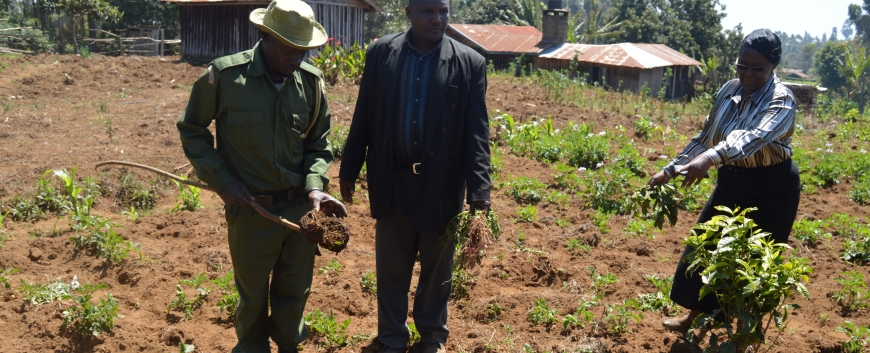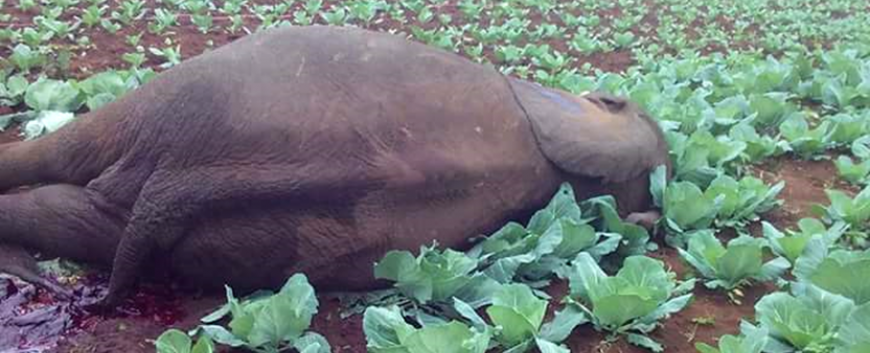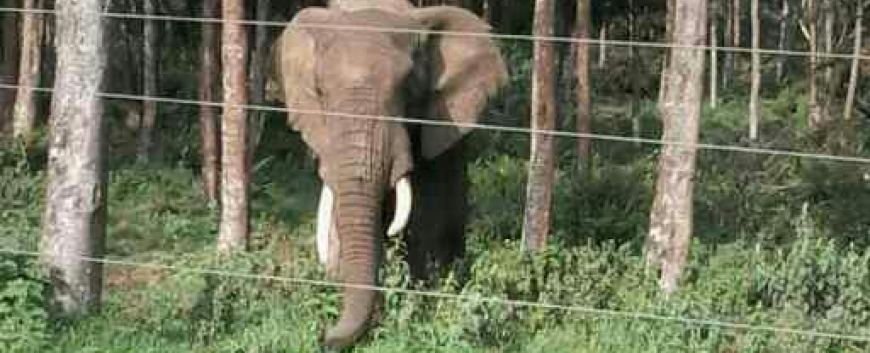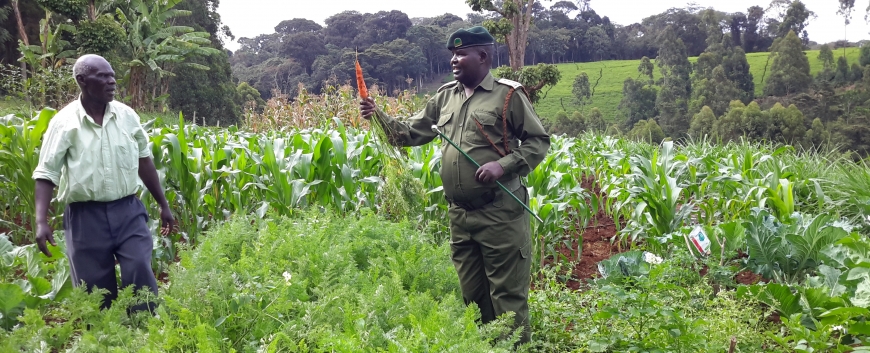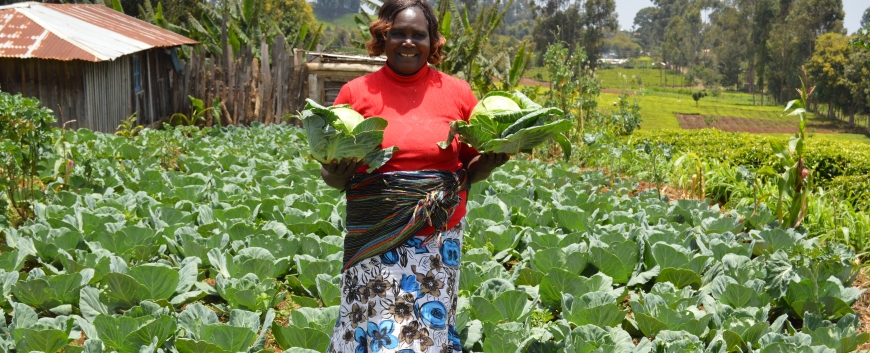THE FENCE THAT SECURED THE HOMES OF MAN AND BEAST
The black night of January 17, 1990 will forever remain etched in Patrick Njagi’s mind.
It is the night that his father Apiel Njoka alias Karu was trampled to death by a marauding elephant.
Njagi, then 17, escaped death by a whisker.
“It was around 9PM on a moonlit night. My dad and my younger siblings were in the house engaged in small talk as we waited for dinner to be served. I heard heavy sounds emanating from the direction of our farm and cautiously walked into the darkness to check. Standing not far away from the house, I could pick out gigantic silhouettes accompanied by low but deep rumbles characteristic of the world’s largest land mammal. Elephants. There was a whole herd of them happily chewing away at our banana plantation. About a hundred meters away to the right was the all familiar pitch- dark outline of Mt Kenya forest.
Revered in the tourism world for their large size and majestic mannerisms, a herd of elephants in a peasant’s farm epitomized terror and often resulted in unbearable losses, both physical and to life.
“Ours is a homestead on the frontline, but we never quite got accustomed to the pain of crop loss due to crop raiding by elephants. I immediately rushed back to the main house and alerted my father about it.” recalls Njagi.
As fate had it that night, his father unknowingly entered the plantation from the side where an elephant stood disguised by banana crops, then hell broke loose!
Njagi was a few metres away when the beast gored his father and trampled on him, critically injuring him.
“Looking at my dad lying on the ground lifeless, I was a mixed bag of emotions. Confused, helpless, shocked. I was too aware the jumbo that had gored his stomach open could be anywhere near where he lay ready to attack again. I ran for help, but passed out barely 10 metres from the scene. The shock was too much.”
Njagi eventually managed to call for help. Unfortunately, his father died before they could get assistance to ferry him to a hospital.
His father’s death shocked residents of Kericho village in Magumoni location, Tharaka-Nithi County.
Bordering Mt Kenya forest, the forlorn village has borne countless onslaughts from jumbos that strayed from the forest and ate from the farmlands relegating peasant farmers to lives of misery.
For Njagi, his father’s death dealt a terrible blow to him as it marked a critical turning point in his life. To place food on the table, his father would do casual jobs as a lumberjack while his mother was a housewife taking care of him and his seven siblings. There’s no way he would fit in his father’s shoes as a breadwinner while attending school. Consequently, he dropped out of school in form two and engaged in odd jobs to fend for the family. Life was tough, and jobs were scarce. None of his siblings managed to go past class eight.
Elephants are known to be far-ranging animals and heavy feeders. For an adult elephant, the daily requirement for food and water can reach 300kg of vegetable matter and 200 litres of water. It is for this reason that they find farmlands close to their habitats an attractive food source for succulent crops, and are known to wipe out entire farms in a single night.
Njagi’s struggle after the tragic demise of his father and the subsequent toll it had on the family mirrors that of thousands of residents who neighbour the expansive Mt Kenya forest in parts of Embu, Tharaka-Nithi, Meru, Kirinyaga and Nyeri Counties.
Whereas their lands are fertile and rainfall is plentiful, the communities in this region have for decades been victims of elephants and other wildlife raids on their farms. Lives have been lost and injuries suffered when enraged farmers, armed with all manner of crude weapons, attempt to scare away the elephants. Clearly, at all times for farmers living along the forest edge, the elephant in the room was always the elephant in the farm.
“The age-old conflict between man and beast is one bound to escalate into an all-out confrontation as humans encroach into wildlife habitat in search of settlement land and livelihood. The relationship between humans and wildlife ought to be different…it doesn’t have to be defined by conflict” Says Ms. Faith Muthoni Livingstone, the project coordinator for the Upper Tana Natural Resources Management Project (UTaNRMP). UTaNRMP is a multi-sectoral project funded by the government of Kenya, the international Fund for Agricultural Development (IFAD), Spanish Trust Fund and local communities with the objectives of increasing sustainable food production and incomes for poor rural households and sustainable management of natural resources for provision of environmental services.
The sad lives of communities neighboring the section of Mt Kenya forest in Tharaka Nithi and parts of Meru counties is now a thing of the past. Thanks to the construction of a solar electricity human-wildlife control fence that separates the forest from farmlands.
Solar powered electric fence
The construction of the 60 km fence, from River Thuci at the boundary of Embu and Tharaka Nithi counties to River Thingithu in Meru County was completed in June 2016.
The fence was a joint effort of the Upper Tana Natural Resources Management Project (UTaNRMP), Rhino Ark, Mt Kenya Trust ,Kenya Wildlife Services (KWS), Kenya Forestry Services (KFS) and the communities living near the forest. Each of these partners had their roles and responsibilities in the fence construction well spelled out in a management agreement that had UTaNRMP finance the fence materials and community sensitization meetings, Rhino Ark and Mt Kenya Trust financed the cost of labour as well as providing tools and equipment for the construction, KWS provided the fence design, technical guidance, constructed the energizer houses and offers security while KFS participated in fence alignment, conducted community sensitization for ownership and sustainability. The community members living near the forest provided unskilled labour through their community forest associations. For sustainability, the communities living along the forest edge have user rights through the community forest associations (CFAs) and the chair person sits in the fence implementation committee. For every 8 kilometres of fence covered 1 member of the local CFA is absorbed by KWS to maintain, guard and patrol the fence.
Described as a comprehensive fence, it has eight strands of wire and a one meter mesh (tight lock) at the bottom that prevents burrowing animals from crossing over into farmlands.
Paul Njuguna, UTaNRMP’s Land and Environment Coordinator, notes that the synergies from partners constructing the fence resulted in the reduction of the expected completion time from 6 years to 2 years and advocates for the adoption of the approach in completing the un-fenced section of the forest. This is further emphasized by Christian Lambrechts, the CEO Rhino Ark who adds that “there’s still more ground to cover before we can finally say Mt Kenya forest is fully fenced. We encourage more potential partners to come in and join the noble cause.”
The Mount Kenya forest reserve is among the largest in Kenya and its ecosystem plays a critical role in water catchment for two main rivers in the country, the Tana and Ewaso Ng’iro. According to the Kenya Wildlife Services, the Mount Kenya ecosystem supports the country’s largest remaining forest population of elephants estimated at 2000-3000 individuals. Due to its significance, the Mt Kenya ecosystem was declared a world heritage site by UNESCO in 1997.
The fencing has controlled illegal activities within the forest reserve since any entry and exit from the forest is via designated gates and entry points are limited.
According to Simon Gitau (right), an Assistant and a former senior warden at the Mt Kenya National Park and Reserve, the Mount Kenya ecosystem health has improved through reduced illegal activities while the relationship between the government agencies (mainly KFS and KWS) and communities has become cordial for the benefit of the ecosystem.
Cumulatively, constructing the fence costed approximately 150 million with UTaNRMP contributing KShs.126 million.
Flourishing farming and Peace Of Mind
Once the elephants were confined to the forests, farmers gave a collective sigh of relief from the dark and cold nights they stayed awake and fight off the elephants.
It also marked the end of their economic losses caused by elephants as their maize, banana, tubers and vegetables now flourish to maturity till harvest.
Lilian, a widow and a mother of one, has her home bordering the forest in Mucheege area of Meru county. For her, being a widow increases existing vulnerabilities to the impact of human-wildlife conflicts. Owing to the risk involved, going out to chase elephants at night has always been done by men in her Meru community. Denis, her son, is 14years old and in form one in a nearby boarding school. Often times before the fence was constructed, Lilian would helplessly cry the night away as elephants feasted on her snow peas and irish potatoes. In such times, the neighbors would be very busy protecting their farms. The thought of her entire crop being destroyed, and in effect threatening the education of her son was too much to bear. All that is behind her now. With the fence in place, every break of dawn is a new opportunity to secure her future and that of her son. Tilling the farm is no longer a futile endeavor. With about one and a quarter acre of her farm taken up by a tea plantation and the homestead, Lilian now makes about over ninety five thousands per a 3-months season from the remaining three quarter acres.
Ten kilometers up from Mucheege, Mr & Mrs. Julius Mbaya are all praises for the fence. Every section of their farm in Marimba area of Meru County has been put under crops that they had previously shunned because they were branded elephant delicacies. There are neat rows of cabbages ready for harvest at one end of the farm, green peas and bananas occupy another. There is a relatively large section of the farm that has a happy crop of irish potatoes. Without any cue, Mrs Mbaya uproots one to reveal a heavy bunch of red-skinned tubers. Two of them the size of a baby’s head.
Patrick Njagi, on the other hand, considers his family to be the greatest beneficiary of the fence, seeing it as a partial reparation to their father’s death from the elephants.
“After the fence was constructed, I’ve not had a case of wildlife straying into my farm. I grow whichever crop I feel like, and delight in seeing it mature to harvest time without experiencing an attack from elephants,” he says.
Another beneficiary is Festus Muthanga Kiganka. A retired teacher who bought a piece of land in Kericho village in 1983 and relocated there.
He was attracted by its productivity and thus planted bananas, maize and sugarcane.
Just as his healthy crops flourished promising a bountiful harvest, the elephants, which frequented the area at the onset of their birthing, raided the farm for several successive nights and destroyed all his crops.
“We would try to use fire and beating empty tins to scare away the beasts. This at times worked, albeit temporarily, and in some cases resulted in casualties. Informing the Kenya Wildlife Service officers was in most cases futile since the incidences would overwhelm them. Compensation from the government was pittance and would take ages if at all you were lucky to get it” he reminisces.
The following year, Muthanga planted Napier grass thinking the jumbos would not eat it, but he was wrong as they ferociously munched it all.
Left a dejected and bitter farmer, he planted tea on most of his farm, since elephants do not eat it.
Now that the fence has put to stop the human-wildlife conflicts, Muthanga has since replanted bananas, sugarcane, arrow roots, yams and maize in his farm.
Needless to say, there are other benefits of the fence that are not obviously apparent. Before the fence was constructed, social engagements after dusk was not a common thing due to the fear of bumping onto a jumbo.
“Bumping onto an elephant can be an incredibly scary experience. We are now able to walk at night without the fear of coming across an elephant. Children can go to school early and come home late without the danger of being attacked. There’s social warmth in the village unlike before the fence” Says Muthanga. He also notes that land value has appreciated and buyers are now not fearful of buying land in the area.
Agapio Kimotho, another resident, observes that elephants mainly raided farms when the maize was in the tussling stage and they would in one night wipe out all that a farmer had toiled for months.
“They targeted potatoes that were in the flowering stage. In some cases they would even demolish houses or granaries to access the maize stored there,” he remembers.
Curiously enough, Agapio and a good number of farmers bordering the forest had planted closely-spaced trees along their farm boundaries as an attempt to keep away marauding elephants. This did not entirely bear fruits since elephants are wont to destroying young trees by uprooting and debarking. The few trees that survived stand tall in formation like a cavalry of soldiers facing the forest, barely 100m away, from whence the enemy used to come. The rugged striped scars on their barks, made by elephant tusks during debarking, worn as badges of honor to signify a history in action. All that is now in the past. The fence beat them in reigning in the jumbos. Ironically, but justifiably so, Agapio relishes the defeat.

